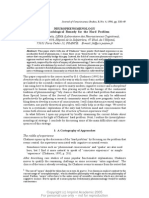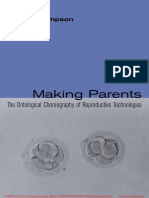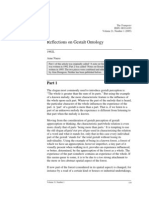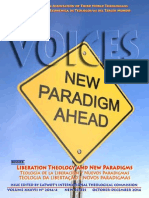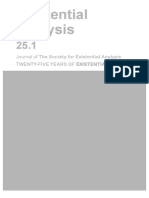Peter-Paul Verbeek - Cyborg Intentionality: Rethinking The Phenomenology of Human-Technology Relations
Peter-Paul Verbeek - Cyborg Intentionality: Rethinking The Phenomenology of Human-Technology Relations
Uploaded by
Kris Cowell LlorensCopyright:
Available Formats
Peter-Paul Verbeek - Cyborg Intentionality: Rethinking The Phenomenology of Human-Technology Relations
Peter-Paul Verbeek - Cyborg Intentionality: Rethinking The Phenomenology of Human-Technology Relations
Uploaded by
Kris Cowell LlorensOriginal Title
Copyright
Available Formats
Share this document
Did you find this document useful?
Is this content inappropriate?
Copyright:
Available Formats
Peter-Paul Verbeek - Cyborg Intentionality: Rethinking The Phenomenology of Human-Technology Relations
Peter-Paul Verbeek - Cyborg Intentionality: Rethinking The Phenomenology of Human-Technology Relations
Uploaded by
Kris Cowell LlorensCopyright:
Available Formats
Phenom Cogn Sci (2008) 7:387395 DOI 10.
1007/s11097-008-9099-x
Cyborg intentionality: Rethinking the phenomenology of humantechnology relations
Peter-Paul Verbeek
Published online: 26 June 2008 # Springer Science + Business Media B.V. 2008
Abstract This article investigates the types of intentionality involved in human technology relations. It aims to augment Don Ihdes analysis of the relations between human beings and technological artifacts, by analyzing a number of concrete examples at the limits of Ihdes analysis. The article distinguishes and analyzes three types of cyborg intentionality, which all involve specific blends of the human and the technological. Technologically mediated intentionality occurs when human intentionality takes place through technological artifacts; hybrid intentionality occurs when the technological actually merges with the human; and composite intentionality is the addition of human intentionality and the intentionality of technological artifacts. Keywords Intentionality . Humantechnology relations . Cyborg . Posthumanism . Don Ihde
Introduction The figure of the cyborg has been functioning as a key to understanding what it means to be a human being in a technological culture, ranging from Donna Haraways farewell to naturalist accounts of the human (Haraway 1991) to Nick Bostroms utopian plea for transhumanism (Bostrom 2004). A cyborg is a borderblurring entity, uniting both human and nonhuman elements. Humans and nonhumans are often considered to be separated by a deep ontological abyss, the one active and intentional, the second passive and mute (Latour 1993; Heidegger 1977). Conceptualizing entities which merge the human and the technological therefore requires a radical metaphysical step and a thorough recalibration of central philosophical notions. Yet, we have become such entities, as many authors have
P.-P. Verbeek (*) Department Philosophy, University of Twente, Enschede, The Netherlands e-mail: P.P.C.C.Verbeek@gw.utwente.nl
388
P.-P. Verbeek
argued in more or less radical degrees (Ihde 1990; Haraway 1991; Latour 1993; Hayles 1999; De Mul 2002; Irrgang 2005). What is more, authors like Bernhard Stiegler argue that we have always been cyborgs in a sense, since technology can be seen as constitutive for humanity. For Stiegler, humanity is an invention of technology, rather than the other way round; human beings exist by realizing themselves technologically (cf. Stiegler 1998). We would not have been the human beings we are, had we not used the technologies we use and this goes far beyond the physical interactions we have with technologies. Without writing, for instance, our cultural frameworks of interpretation would have been radically different. In this article, I will use the figure of the cyborg to reconceptualize a specific phenomenon which has long been considered to be exclusively human: the phenomenon of intentionality. I will do so by investigating various types of relations between humans and technologies. How to understand cyborg intentionality? Is it simply a technologically influenced form of human intentionality? Or can blends of human and nonhuman beings have an intentionality of their own? Does something like technological intentionality exist, and if so, how is it related to human intentionality? Or can human intentionality simply not be understood without taking into account how it is intertwined with technology, as would follow from Stiegler s perspective of originary technicity? In order to answer these questions I will first briefly introduce the concept of intentionality, as it has developed in phenomenology. After that, I will investigate how to understand this concept of intentionality in the context of humantechnology associations. On the basis of the work of Don Ihde, I will elaborate the notion of mediated intentionality as a central form of cyborg intentionality. After this, I will augment Ihdes analysis with two other forms of cyborg intentionality, which I will call hybrid intentionality, in which humans and technology merge rather than interact, and composite intentionality, in which there is an interplay between human intentionality and the intentionalities of technologies themselves.
Intentionality and technology In the phenomenological tradition, especially in the existential and embodied directions it took in the work of Jaspers, Heidegger, and Merleau-Ponty, intentionality is the core concept to understand the relation between human beings and their world. Rather than separating humans and world, the concept of intentionality makes visible the inextricable connections between them. Because of the intentional structure of human experience, human beings can never be understood in isolation from the reality in which they live. Humans are always directed toward reality. They cannot simply think, but they always think something; they cannot simply see, but they always see something; they cannot simply feel but always feel something. As experiencing beings, humans cannot but be directed at the entities which constitute their world. Conversely, it does not make much sense to speak of the world in itself either. Just like human beings can only be understood from their relation with reality, so can reality only be understood from the relation human beings have with it. The world in itself is inaccessible by
Cyborg intentionality
389
definition, since every attempt to grasp it makes it a world for us, as disclosed in terms of our specific ways of understanding and encountering it (cf. Verbeek 2005). Don Ihde has introduced a technological dimension in this phenomenological tradition of understanding humanworld relations. In our technological culture, many of the relations we have with the world around us are either mediated by or directed at technological devices ranging from looking through a pair of glasses to reading off a thermometer, from getting money from an ATM to having a telephone conversation, and from hearing the sound of the air conditioner to having an MRI scan made. Ihdes analysis lays bare a first manifestation of cyborg intentionality, which can be called mediated intentionality. Mediated intentionality Ihde (1990) discerns several relationships human beings can have with technological artifacts. Firstly, technologies can be embodied by their users, establishing a relationship between humans and their world. When looking through a pair of glasses, the glasses are not noticed explicitly but are incorporated; they become extensions of the human body. Secondly, technologies can be the terminus of our experience. In this alterity relation, human beings interact with a device, as is the case when taking money from an ATM. A third humantechnology relation is the hermeneutic relation. In this relation, technologies provide representations of reality, which need interpretation in order to constitute a perception like a thermometer, which does not produce an actual experience of heat or cold, but delivers a value which needs to be read in order to tell something about temperature. The fourth humantechnology relation Ihde distinguishes, is the background relation, where technologies are not experienced directly, but rather create a context for our perceptions, like the humming of the air conditioning, or the automatic switching on and off of the refrigerator, et cetera. These four human technology relationships, on the basis of which technologies play their mediating roles, are indicated schematically in Fig. 1. In this figure, the arrow indicates human intentionality. As the figure makes visible, there are interesting relations between intentionality and technology. Intentionality can work through technological artifacts, it can be directed at artifacts and it can even take place against the background of them. In all of these cases, except the alterity relation, human intentionality is mediated by a technological device. Humans do not experience the world directly here, but always via a mediating artifact which helps to shape a specific relation between humans and world. Binoculars, thermometers, and air conditioners help to shape new experiences, either by procuring new ways of accessing reality or by creating new
Fig. 1 Humantechnology relationships (Ihde 1990)
embodiment relation hermeneutic relation alterity relation background relation
(human technology) human human
world
(technology world) technology (- world)
human ( technology world)
390
P.-P. Verbeek
contexts for experience. These mediated experiences are not entirely human human beings simply could not have such experiences without these mediating devices. Experiences like reading off a thermometer and having a telephone conversation, therefore, involve cyborg intentionality intentionality that is partly constituted by technology. Intentionality beyond mediation Yet, more radical elaborations of cyborg intentionality need to be developed. Beside mediated intentionality, I would like to distinguish two other forms of intentionality related to humantechnology associations. First, I would like to introduce the concept of hybrid intentionality, indicating the intentionality of humantechnology hybrids, in which the human and the technological are merged into a new entity, rather than interrelated, as in Ihdes humantechnology relations. And second, I will develop the notion of composite intentionality to indicate situations in which not only human beings have intentionality, but also the technological artifacts they are using. These additional forms of cyborg intentionality should be seen as radicalizations of two of Ihdes humantechnology relations, which become visible when these relations are explicitly approached from the point of view of intentionality. Because Ihdes primary focus is on the relations between humans and technologies rather than the intentionalities involved, his analysis tends to blackbox the various forms of intentionality involved in these relations. Drawing attention to these intentionalities makes it possible to substantially augment his analysis. Ihdes schematic representations of humantechnology relations do not only contain arrows, indicating intentionality, but also dashes, indicating a relation between entities which is not specified further. If we limit ourselves to the embodiment relation and the hermeneutic relation which are the most relevant relations in the context of intentionality since they ultimately involve relations with the world these dashes indicate a relation between humans and technology or between technology and world. It is precisely by investigating the nature of these dashes that a closer characterization can be developed of what can be called cyborg intentionality. First, the dash between humans and technology in the embodiment relation (humantechnology) world blackboxes the specific nature of the various relations that can exist here between humans and technology, and which are extremely relevant in the context of cyborg intentionality. Second, the dash between technology and world in the hermeneutic relation human (technologyworld) blackboxes the specific relations that can exist between mediating technologies and the world. More specifically, it does not create enough space to take into account the existence of nonhuman or technological intentionality, which are highly relevant too in the context of a discussion about cyborg intentionality. In the following sections, therefore, I will augment Ihdes understanding of both the embodiment relation and the hermeneutic relation.
Hybrid intentionality Analyzing the nature of the relations between the human and the technological in the embodiment relation makes clear that, in fact, a fifth variant could be added to Ihdes
Cyborg intentionality
391
overview of humantechnology relations. In Ihdes range of humantechnology relations, technology moves ever further away from the human from being embodied to being read, to being interacted with and even being merely background. Yet, prior to the embodiment relation there are humantechnology relations in which the human and the technological actually merge rather than merely being embodied. These humantechnology relations are the ones usually associated with bionic beings, or cyborgs, being half organic, half technological. When microchips are implanted to enhance the vision of visually impaired people, when antidepressants help to change peoples mood, or when artificial valves and pacemakers help to make peoples heart beat, there is no embodiment relation anymore at least, not a relation which could compare to wearing eyeglasses or using a telephone. True, in both cases it is an association of a human being and a technological artifact that experiences reality, but in the bionic or cyborg association there actually is no association of a human and a technology anymore. Rather, a new entity comes about. Instead of organizing an interplay between a human and a nonhuman entity, this association physically alters the human. The resulting cyborg relation can be indicated as:
Cyborg relation (human/technology) world
This fifth humantechnology relation is the basis for what can be called hybrid intentionality. Rather than being a technologically mediated form of human intentionality, this form of intentionality is beyond the human. Just like the being which experiences reality under the influence of drugs, or which sees things with the help of an implanted microchip, is not entirely human, so is the intentionality involved here. To be sure, the intentionality involved in the embodiment relation is not entirely human either: the specific ways in which humans are directed at each other through a mobile phone, or hear through a hearing aid, can only exist by virtue of an intimate humantechnology association. But in these embodiment relations, a distinction can still be made between the human and the technological share in the mediated experience, while this is not possible in cyborg relations, where humans and technology form a new experiencing entity. In order to articulate the difference between these two forms of cyborg intentionality, or being a cyborg, it is helpful to distinguish two distinct ways of moving beyond the human. First of all, a posthumanist approach can be taken, in which the analysis of humantechnology relations urges us to move beyond humanism as a very specific and all-too-human approach of what it means to be a human being; in order to understand what it means to be a human being, we need to take into account how the human and the technological co-constitute each other. Stiegler s thesis of originary technicity, which I mentioned before, can be seen as representative of this approach. Second, there is a transhumanist approach, which does not see humantechnology relations in terms of constitution but in terms of an actual, physical fusion. Here, we do not move beyond humanism but beyond the human; humans and technologies merge into a new entity, which is sometimes even considered to be the successor of Homo sapiens. This distinction actually reflects Peter Sloterdijks analysis of anthropotechnologies in his infamous lecture but fascinating lecture Rules for the anthropic
392
P.-P. Verbeek
garden (Sloterdijk 1999). This lecture is a reply to Martin Heidegger s Brief ber den Humanismus, in which Heidegger explained why the popular associations of his work with humanism were entirely wrong. Humanism, according to Heidegger, approaches the human being from the perspective of the animal: as zoon logon echon or animal rationale an animal with speech and reason. This continuity between human and animal, Heidegger says, ignores the radical difference between them, which he locates in the human capacity to think the being of beings. Sloterdijk, however, reversed Heidegger s argument. He, too, wants to move beyond humanism, but for entirely different reasons. The humanist tradition, he says, has always tried to cultivate the human being; to tame it with the help of texts and in that sense, Heidegger was a humanist too. But technological developments have now made it possible to cultivate human beings in quite a different way: by literally breeding or growing them. And rather than shying away from the technological possibility to alter the biological constitution of the human being, Sloterdijk urges that we should take responsibility for the powers we have developed. We should get beyond the humanist preoccupation with texts, and start thinking about moral guidelines for how to use the new anthropotechnologies. Both of these readings of the cyborg have implications for our understanding of cyborg intentionality. Ihdes approach revolves around technologically mediated intentionality, in which both (mediated) human beings and (multistable) technological artifacts are constituted. But the cyborg notion behind the concept of hybrid intentionality, as I elaborate it here, articulates how humantechnology relations can also get a physical character, forming an actual amalgam of the human and the technological, as is the case when pieces of technology are actually merged with the human body. Technologies used, like telescopes and hearing aids, help to constitute us as different human beings, whereas technologies incorporated constitute a new, hybrid being which could, in principle, also use technologies which help to constitute as different transhumans. Composite intentionality1 A third form of cyborg intentionality that deserves a closer analysis, beside its mediated and hybrid variants, can be called composite intentionality. In this case, the intentionalities of technological artifacts themselves play a central role, in cooperation with the intentionalities of the human beings using these artifacts. Technological intentionality here needs to be understood as the specific ways in which specific technologies can be directed at specific aspects of reality. In this context, for instance, Don Ihde elaborated the example of the sound recorder as having a different intentionality for sound than human beings have, recording background noises at a louder volume than perceived by human beings who only focus on the sounds that are meaningful to them in that specific situation (Ihde 1979: 7778; Ihde 1983: 56; Ihde 1990: 102103). When this directedness of
1 Parts of this section incorporate reworked fragments from P.P. Verbeek, Beyond the Human Eye: Mediated Vision and Posthumanity, in: P.J.H. Kockelkoren (ed.), Proceedings of AIAS Conference. Published online at: http://www.aias-artdesign.org/mediatedvision.
Cyborg intentionality
393
technological devices is added to human intentionality, composite intentionality comes about: a form of intentionality which results from adding technological intentionality and human intentionality. Composite intentionality plays a role in what Ihde calls the hermeneutic relation. After all, hermeneutic relations always involve a technologically generated representation of the world, which inevitably is the product of a specific technological directedness at the world: thermometers focus on temperature, spectrographs on light frequencies, sonograms on how material objects reflect ultrasound. Yet, this representing intentionality of nonhuman perceivers is only one form of composite intentionality. Not all technological intentionalities are directed at actually representing a phenomenon in the world some of them, e.g., rather construct reality, like radio telescopes that produce a visible image of a star on the basis of seeing radiation which is not visible to the human eye. In this case, one could say the composition of human intentionality and technological intentionality is directed at making accessible ways in which technologies experience the world. The concept of composite intentionality, therefore, urges us to augment Ihdes analysis of the hermeneutic relation. There is a double intentionality involved here; one of technology toward its world, and one of human beings toward the result of this technological intentionality. In other words: humans are directed here at the ways in which a technology is directed at the world. This implies that, to conceptualize the basis for composite intentionality, the dash in Ihdes schematic depiction of the hermeneutic relation human (technologyworld) should be replaced with an arrow. This gives the following scheme:
composite relation human (technology world)
A good source to investigate such composite intentionalities is art. In what follows, I would like to elaborate the phenomenon of composite intentionality by briefly discussing the ways in which two Dutch artists explore new regimes of perception with the help of technologies. The artworks I will discuss explicitly explore and demonstrate the intentionalities of technological artifacts in relation to human intentionality.2 But rather than putting these intentionalities in the service of human relations to the world as is the case in Ihdes hermeneutic relations they explore technological intentionalities as relevant in themselves. They aim to reveal a reality that can only be experienced by technologies, by making accessible technological intentionalities to human intentionality. Augmented intentionality The night photographs of Wouter Hooijmans embody the mildest form of composite intentionality. Hooijmans makes landscape photographs using shutter times of several hours. This allows him to make use of starlight for exposing his pictures, which has stunning effects. All short incidents, like animals walking through the image, movements of the leaves on a tree, ripplings of the water in a
2
Some works of the artists discussed can be viewed at http://www.aias-artdesign.org/mediatedvision.
394
P.-P. Verbeek
lake, become irrelevant. Only things that last make it to the picture. Hooijmanss photographs reveal the world as it would look if we would not need to blink our eyes. In a sense, his pictures can be seen as the embodiment of Husserls method of essential intuition. By imaginatively transforming a phenomenon in various ways, Husserl wanted to determine which aspects are essential to it and which are not. Hooijmanss images seem to accomplish this not in the realm of ideas but in the materiality of a printed photograph. Hooijmanss photographs embody an extreme mechanical makeover of the intentionality of the human vision. Contrary to the most common use of the photo camera, Hooijmans does not create instantaneous exposures, but rather sustained exposures. His photographs blend together an infinite number of visual impressions into one single representation of the world, which the human eye could never produce itself. We could call this form of composite intentionality augmented intentionality, since it consists in making accessible to the human eye an artificially expanded form of human intentionality. Constructive intentionality The stereophotographic work of De Realisten (The Realists) embodies a second form of composite intentionality. As a part of their work, De Realisten have been making stereographic photographs of several sets of identically shaped objects, made out of different and non-amalgamating materials, like wood and bronze. Looking at these photographs with the help of 3d equipment, one is confronted with highly realistic, three-dimensional representations of a reality which cannot exist in everyday experience. These photographs do not aim to represent reality in any sense, but to generate a new reality which can only exist for human intentionality when it is complemented with technological intentionality. The resulting three-dimensional, photorealistic amalgams have no original counterpart in everyday reality. The intentionality that De Realisten gave to their stereographic camera is not directed at making visible an existing reality but at constructing a new reality. For this reason, the intentionality involved here can be called constructive intentionality.
Conclusion Technological development has reached a stage in which technology has started to interfere explicitly with the nature of human beings. Intentionality used to be one of these concepts which belonged to the realm of the exclusively human, but by now it has become clear that it needs to be extended to the realm of technology and to the realm of humantechnology amalgams. When Friedrich Nietzsche (1969/1883) wrote the famous words that Man is a rope, stretched between the animal and the bermensch, he could not possibly foresee that they were prophetic in a very concrete and material sense. By re-articulating phenomenological and philosophical anthropological concepts philosophers can contribute to a better understanding of the posthuman or perhaps even transhuiman beings we are becoming and to the development of a better sense of the limits of humanity.
Cyborg intentionality
395
Acknowledgement This article was written with financial support of NWO, the Netherlands Organization for Scientific Research.
References
Bostrom, N. (2004). The future of human evolution. In Ch. Tandy (Ed.), Death and anti-death: two hundred years after Kant, fifty years after Turing (pp. 339371). Palo Alto, CA: Ria University Press. De Mul, J. (2002). Cyberspace Odyssee. Kampen: Klement. Haraway, D. (1991). A cyborg manifesto: science, technology, and socialist-feminism in the late twentieth century. In D. Haraway (Ed.), Simians, cyborgs and women: the reinvention of nature (pp. 149181). New York: Routledge. Hayles, K. (1999). How we became posthuman. Chicago: University of Chicago Press. Heidegger, M. (1977). The age of the world picture. In M. Heidegger (Ed.), The question concerning technology and other essays. New York: Harper & Row (translated by W. Lovitt). Ihde, D. (1979). Technics and Praxis. Dordrecht: Reidel. Ihde, D. (1983). Existential technics. Albany: State University of New York Press. Ihde, D. (1990). Technology and the lifeworld. Bloomington/Minneapolis: Indiana University Press. Irrgang, B. (2005). Posthumanes Menschsein. Stuttgart: Franz Steiner Verlag. Latour, B. (1993). We have never been modern. Cambridge, MA: Harvard University Press (translated by C. Porter). Nietzsche, F. (1969/1883). Thus spoke Zarathustra: a book for everyone and no one. London: Penguin Books. Sloterdijk, P. (1999). Regeln fr den Menschenpark: Ein Antwortschreiben zu Heideggers Brief ber den Humanismus. Frankfurt/M: Suhrkamp. Stiegler, B. (1998). Technics and time 1: The fault of Epimetheus. Stanford: Stanford University Press. Verbeek, P. P. (2005). What things do: Philosophical reflections on technology, agency, and design. University Park, PA: Penn State University Press.
You might also like
- Vita-More - The Transhumanist Manifesto - Humanity+Document12 pagesVita-More - The Transhumanist Manifesto - Humanity+asdfafdsgNo ratings yet
- Verbeek, Peter-Paul - Rosenberger, Robert - Postphenomenological InvestigationsDocument4 pagesVerbeek, Peter-Paul - Rosenberger, Robert - Postphenomenological InvestigationsThamires Ribeiro de MattosNo ratings yet
- Neuro PhenomenologyDocument20 pagesNeuro PhenomenologycacoozrNo ratings yet
- 163-Making Parents The Ontological Choreography of Reproductive Technologies-Charis Thompson-026Document375 pages163-Making Parents The Ontological Choreography of Reproductive Technologies-Charis Thompson-026Priscilla EcheverriaNo ratings yet
- Muniesa, Millo, Callon (2007) - Market DevicesDocument319 pagesMuniesa, Millo, Callon (2007) - Market DeviceslucccavlNo ratings yet
- Parisi Abstract SexDocument236 pagesParisi Abstract SexKris Cowell LlorensNo ratings yet
- Philosophy of Mind (Guidebook)Document98 pagesPhilosophy of Mind (Guidebook)Nathaniel Moore100% (8)
- Carlos Castaneda - Eagles Gift - Readers of InfinityDocument56 pagesCarlos Castaneda - Eagles Gift - Readers of InfinityDorian MartinNo ratings yet
- Perler (Ed.) - Ancient and Medieval Theories of Intentionality PDFDocument183 pagesPerler (Ed.) - Ancient and Medieval Theories of Intentionality PDFDaniel Andres Ortega OjedaNo ratings yet
- Zalta, E. N. - Intensional Logic and The Metaphysics of IntentionalityDocument270 pagesZalta, E. N. - Intensional Logic and The Metaphysics of IntentionalityBruno SbranciaNo ratings yet
- Through A Glass, DarklyDocument337 pagesThrough A Glass, DarklyAnonymous BQk0XrKBE67% (3)
- Haugeland J. Having Thought - Essays in The Metaphysics of MindDocument400 pagesHaugeland J. Having Thought - Essays in The Metaphysics of MindGermán Alberto Valencia Guzmán0% (1)
- Interpretive Social ScienceDocument8 pagesInterpretive Social ScienceannahsenemNo ratings yet
- Stengers, Isabelle - The Challenge of Ontological PoliticsDocument36 pagesStengers, Isabelle - The Challenge of Ontological PoliticsIsadora SimonNo ratings yet
- School As Soil - Pedagogies of Care For Alternative Future Imaginaries (2023)Document18 pagesSchool As Soil - Pedagogies of Care For Alternative Future Imaginaries (2023)湯凱傑No ratings yet
- Autopoiesis PDFDocument44 pagesAutopoiesis PDFnicolasdizzNo ratings yet
- The Irreducible Complexity of ObjectivityDocument28 pagesThe Irreducible Complexity of ObjectivityAbraham LilenthalNo ratings yet
- Yuk Hui - After The Organic v2Document9 pagesYuk Hui - After The Organic v2Rafael SaldanhaNo ratings yet
- Gilbert Simondon - Two Lesson On Animal and MenDocument48 pagesGilbert Simondon - Two Lesson On Animal and MenSávio GomesNo ratings yet
- From Complementarity To Obviation IngoldDocument15 pagesFrom Complementarity To Obviation IngoldjohanakuninNo ratings yet
- Gianni Vattimo On CultureDocument18 pagesGianni Vattimo On CultureAbbass BrahamNo ratings yet
- Naess A., (1973) The Shallow and The Deep, Long-Range Ecology Movement, A Summary PDFDocument7 pagesNaess A., (1973) The Shallow and The Deep, Long-Range Ecology Movement, A Summary PDFChechoReyes100% (1)
- 39 1 Delpech-RameyDocument17 pages39 1 Delpech-Rameyalpar7377No ratings yet
- Esteva Commoning in The New SocietyDocument16 pagesEsteva Commoning in The New SocietyMotin-drNo ratings yet
- Umwelt Ethics: Morten TønnessenDocument19 pagesUmwelt Ethics: Morten TønnessenMorten Tønnessen100% (1)
- 2013 Le Monde Ou La ChairDocument243 pages2013 Le Monde Ou La ChairJan100% (1)
- A Carnival For Science - Essays On Science Technology and DevelopDocument3 pagesA Carnival For Science - Essays On Science Technology and DevelopashfaqamarNo ratings yet
- Interview On François Laruelle's A BIOGRAPHY OF ORDINARY MANDocument7 pagesInterview On François Laruelle's A BIOGRAPHY OF ORDINARY MANTerence BlakeNo ratings yet
- Casanova, José-Religions, Secularisations, ModernitiesDocument21 pagesCasanova, José-Religions, Secularisations, ModernitiesNicolas Antonio JuncalNo ratings yet
- Affimation Versus Vulnerability - On Contemporary Ethical Debates (Rosi BraidottiDocument20 pagesAffimation Versus Vulnerability - On Contemporary Ethical Debates (Rosi BraidottitomerkeNo ratings yet
- No One Has Ever Produced AnythingDocument22 pagesNo One Has Ever Produced AnythingShihâb AlenNo ratings yet
- Philosophy of MedicineDocument42 pagesPhilosophy of MedicineAzad XalilNo ratings yet
- WHR 22Document158 pagesWHR 22TalCualNo ratings yet
- Howes (2022)Document282 pagesHowes (2022)krab4tNo ratings yet
- The Academic Life - Burton Clark PDFDocument375 pagesThe Academic Life - Burton Clark PDFMiguel OrtegaNo ratings yet
- Anthropology of Ontologies Eduardo KohnDocument21 pagesAnthropology of Ontologies Eduardo Kohnbolontiku9No ratings yet
- Isabelle Stengers: Including Nonhumans Into Political Theory: Opening The Pandora Box ?Document18 pagesIsabelle Stengers: Including Nonhumans Into Political Theory: Opening The Pandora Box ?Alejandra PomboSuNo ratings yet
- Arne Naess, Reflections On Gestalt OntologyDocument10 pagesArne Naess, Reflections On Gestalt OntologytathagathanNo ratings yet
- Some Theses On Militant Sound Investigation,: Or, Listening For A ChangeDocument6 pagesSome Theses On Militant Sound Investigation,: Or, Listening For A Changeteamcolors100% (1)
- Pollner 1975 Pollner 411 30Document20 pagesPollner 1975 Pollner 411 30Jack SidnellNo ratings yet
- Natalie Depraz - The Rainbow of Emotions - at The Crossroads of Neurobiology and PhenomenologyDocument23 pagesNatalie Depraz - The Rainbow of Emotions - at The Crossroads of Neurobiology and PhenomenologyjadjemianNo ratings yet
- Benton, Ted - The Philosophical Foundations of The Three SociologiesDocument21 pagesBenton, Ted - The Philosophical Foundations of The Three SociologiesClarissa GalvãoNo ratings yet
- Girls Are Coming Out of The WoodsDocument1 pageGirls Are Coming Out of The WoodsMichelle EscobarNo ratings yet
- Bildung Towards Wisdom, Through Philosophical Dialogue in Teacher EducationDocument15 pagesBildung Towards Wisdom, Through Philosophical Dialogue in Teacher EducationJuan Pablo CortesNo ratings yet
- NAESS, Arne and SESSIONS, George - Basic Principles of Deep EcologyDocument7 pagesNAESS, Arne and SESSIONS, George - Basic Principles of Deep EcologyClayton RodriguesNo ratings yet
- Malabou, Plasticity, and The Sculpturing of The SelfDocument14 pagesMalabou, Plasticity, and The Sculpturing of The SelfSoso Chauchidze100% (1)
- Hermans Dialogical Self in Culture Psychology PDFDocument40 pagesHermans Dialogical Self in Culture Psychology PDFPaulaNo ratings yet
- Peter Sloterdijk Phantastic PhilosophyDocument17 pagesPeter Sloterdijk Phantastic PhilosophyAnarko CrotoNo ratings yet
- "A Way of Seeing": An Intellectual Biography of Denis CosgroveDocument10 pages"A Way of Seeing": An Intellectual Biography of Denis CosgroveBen ConnorNo ratings yet
- Care in Practice MOL PDFDocument14 pagesCare in Practice MOL PDFPedroFragosoNo ratings yet
- Critique of Hallward's Critique of DeleuzeDocument10 pagesCritique of Hallward's Critique of DeleuzeBart P.S.No ratings yet
- Nuevos ParadigmasDocument188 pagesNuevos ParadigmasCristian Saint GermainNo ratings yet
- Ferrando - Towards A Posthumanist Methodology PDFDocument9 pagesFerrando - Towards A Posthumanist Methodology PDFJessica LopezNo ratings yet
- On WhyDocument7 pagesOn WhyNamo ChnameNo ratings yet
- Elias and Moraru, Eds.-The Planetary Turn PDFDocument311 pagesElias and Moraru, Eds.-The Planetary Turn PDFgabrielle1000100% (1)
- Vystopiasamplechapter 2 ClaremannDocument27 pagesVystopiasamplechapter 2 ClaremannNatalia Barrios GuidaNo ratings yet
- Exanal 251Document203 pagesExanal 251Thais De Sa OliveiraNo ratings yet
- Honneth - On The Destructive Power of The ThirdDocument17 pagesHonneth - On The Destructive Power of The ThirddudcrNo ratings yet
- Reference - Kroeber & Kluckhon - TraducciónDocument8 pagesReference - Kroeber & Kluckhon - TraducciónCarlos AcostaNo ratings yet
- 06art GW3Document46 pages06art GW3Filosofía AplicadaNo ratings yet
- Cybernetics Forum 1979 Vol. IX. Issue 3 PDFDocument47 pagesCybernetics Forum 1979 Vol. IX. Issue 3 PDFΜΙΙΙΙΙΤΣΙΑραςNo ratings yet
- Medicine's Symbolic RealityDocument10 pagesMedicine's Symbolic RealitylmanconataniNo ratings yet
- Between Geography and PhilosophyDocument12 pagesBetween Geography and PhilosophyNathália Figueiredo de AzevedoNo ratings yet
- Article Review - The Body As Mediator of The World: Contributions by Maurice Merleau-Ponty and Don Ihde"Document3 pagesArticle Review - The Body As Mediator of The World: Contributions by Maurice Merleau-Ponty and Don Ihde"tsenilas ni shyNo ratings yet
- Postphenomenology and Ethics: Peter-Paul VerbeekDocument10 pagesPostphenomenology and Ethics: Peter-Paul VerbeekGiannopoulos GiannisNo ratings yet
- Philosophy of Man and TechnologyDocument24 pagesPhilosophy of Man and TechnologymutableS100% (1)
- 1.sinclair On RavaissonDocument22 pages1.sinclair On RavaissonKris Cowell LlorensNo ratings yet
- About The Various Definitions of Life - Pier Luigi LuisiDocument10 pagesAbout The Various Definitions of Life - Pier Luigi LuisiKris Cowell LlorensNo ratings yet
- Future Christ - A Lesson in HeresyDocument182 pagesFuture Christ - A Lesson in HeresyMarion Roberson III100% (3)
- Fichte The Science of KnowingDocument271 pagesFichte The Science of KnowingKris Cowell Llorens100% (9)
- Deleuze-Immanence A LifeDocument5 pagesDeleuze-Immanence A LifeKris Cowell LlorensNo ratings yet
- Property and Its Rule (In Late Indo-Islamicate and Early Colonial) South Asia: What's in A Name?Document56 pagesProperty and Its Rule (In Late Indo-Islamicate and Early Colonial) South Asia: What's in A Name?Himanshu ThakurNo ratings yet
- Universal TeleologyDocument5 pagesUniversal TeleologyAntônio MaguevicciNo ratings yet
- This Content Downloaded From 188.251.147.90 On Sun, 03 Oct 2021 00:25:31 UTCDocument29 pagesThis Content Downloaded From 188.251.147.90 On Sun, 03 Oct 2021 00:25:31 UTCjorthwein1No ratings yet
- Christina Gkonou, Dietmar Tatzl, Sarah Mercer Eds. New Directions in Language Learning PsychologyDocument264 pagesChristina Gkonou, Dietmar Tatzl, Sarah Mercer Eds. New Directions in Language Learning PsychologyAlvin Nouval100% (2)
- What Is Place?Document9 pagesWhat Is Place?Tyrese Dre ChettyNo ratings yet
- Critical Realist On DeaconDocument35 pagesCritical Realist On DeaconKomnas PoriazisNo ratings yet
- Vivekananda'S Conception of Normative Ethics and Resolution Ethical Problems in BusinessDocument8 pagesVivekananda'S Conception of Normative Ethics and Resolution Ethical Problems in BusinessYajat BhargavNo ratings yet
- J. E. McGuire - A Dialogue With Descartes. Newton's Ontology of True and Immutable NaturesDocument24 pagesJ. E. McGuire - A Dialogue With Descartes. Newton's Ontology of True and Immutable NaturesvalexandrescuNo ratings yet
- Narrative ComprehensionDocument151 pagesNarrative ComprehensionRicardo De La PeñaNo ratings yet
- UntitledDocument362 pagesUntitledapi-261143747No ratings yet
- PDF The Bloomsbury Companion To The Philosophy of Consciousness 1st Edition Dale Jacquette DownloadDocument49 pagesPDF The Bloomsbury Companion To The Philosophy of Consciousness 1st Edition Dale Jacquette Downloadnosolvjo100% (5)
- Intending and Acting Toward A Naturalized ActionDocument309 pagesIntending and Acting Toward A Naturalized ActionLucas Calonje EspinosaNo ratings yet
- Phenomenology and Phenomenalism: Ernst Mach and The Genesis of Husserl's PhenomenologyDocument22 pagesPhenomenology and Phenomenalism: Ernst Mach and The Genesis of Husserl's PhenomenologyChitrankUpadhyayNo ratings yet
- Manzotti 2019 FrontiersinPsychologyDocument17 pagesManzotti 2019 FrontiersinPsychologyJohn StarrettNo ratings yet
- The Epistemology of Non-Visual PerceptionDocument297 pagesThe Epistemology of Non-Visual PerceptionojodeimprentaNo ratings yet
- Is So Called Phenomenal Intentionality Real Intentionality?: Elisabetta SacchiDocument24 pagesIs So Called Phenomenal Intentionality Real Intentionality?: Elisabetta SacchiArifa'iNo ratings yet
- Code PHIL Course DetailsDocument4 pagesCode PHIL Course DetailsNew TechnologyNo ratings yet
- Cornell Particulars - of - Rapture-An - Aesthetics - of - The - Affects Mar 2003 PDFDocument208 pagesCornell Particulars - of - Rapture-An - Aesthetics - of - The - Affects Mar 2003 PDFGajaules RaducanuNo ratings yet
- Sankara&Husserl On ConsciousnessDocument266 pagesSankara&Husserl On ConsciousnessAnonymous gJEu5X03No ratings yet
- The Nature of Love A Phenomenological Ap PDFDocument123 pagesThe Nature of Love A Phenomenological Ap PDFNatalie SerranoNo ratings yet
- Content and Consciousness Revisited: Carlos Muñoz-Suárez Felipe de Brigard EditorsDocument233 pagesContent and Consciousness Revisited: Carlos Muñoz-Suárez Felipe de Brigard EditorsLaith Atak100% (2)
- What Functions Explain: Functional Explanation and Self-Reproducing SystemsDocument272 pagesWhat Functions Explain: Functional Explanation and Self-Reproducing Systemsraf127carNo ratings yet
- Instant ebooks textbook The Logical Structure of Philosophy, Psychology, Mind and Language in Ludwig Wittgenstein and John Searle - Articles and Reviews 2006-2019 2nd Edition Michael Starks download all chaptersDocument62 pagesInstant ebooks textbook The Logical Structure of Philosophy, Psychology, Mind and Language in Ludwig Wittgenstein and John Searle - Articles and Reviews 2006-2019 2nd Edition Michael Starks download all chapterswakamanerlou100% (2)
- HUSSERLDocument7 pagesHUSSERLleomar875532No ratings yet


